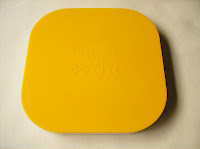 |
| (Click to Enlarge) |
Last year's
31st IPP had some amazing puzzles for the Design Competition, and a few of those have already been reviewed in the blog. Way, by German Volker Latussek, is another great example of this prestigious competition.
"
Way" is more than a simple puzzle. It's a puzzle construction set. The box, built with recycled cardboard materials, comes with 18 pieces/segments made from Beech wood in 4 different types: six C's, four I's, six L's and two S's. All pieces measure 6.8cm in height and 3.4cm in diameter (2.7" x 1.3"). With its pieces, you can solve countless challenges, assembling 2D and 3D structures. The resulting free-standing circuits have to be closed paths, no beginning or end.
(Click to Enlarge) - The Four Types of Pieces: C I L S
Also included in the box is a challenge card with eight puzzles, in different levels of difficulty, to get you started. For many more challenges, just visit the
official puzzle's website. The puzzles vary in number of pieces used, which can go between only 2, up to 18. The only way to do a two-piece circuit is with two C segments. The first four challenges have a picture with the solution, but the following ones (currently 54 published) do not, so you're on your own.
The good thing about the puzzle is that the blocks are quite sturdy and easy to manipulate. You'd think that with more complex circuits, the structure would just collapse in a second, but the weight that the segments put on each other, the circuit becomes very stable once assembled. Now, to get it assembled, that's another story.
While the final shape of the circuit may be stable, the assembling process, mainly when you're building a 3D structure, can be rather difficult. Many times, I found myself struggling to get the pieces to stand without collapsing, resulting in several failed attempts before I was able to succeed. If you can, get someone to help you with the assembling on the harder challenges, as it will become much easier to hold the pieces in place while you fit the remaining ones.
(Click to Enlarge) - 2D & 3D Circuits
As mentioned above, at the time of writing, there are 54 challenges on the puzzle's website. I will list a few ones in 2D and 3D, so you can have a better idea of the types of challenges you're expected to solve. Below, you will only see a picture of the needed pieces for that particular challenge, and if you want to see the final shape, click on the link that will show the solution, to avoid spoilers.
This is challenge #6 and requires six blocks: 2 L's, 1 S and 3 C's. The catch is that you can only have one of the two L's touching the horizontal surface. To see the solution, click
here.
(Click to Enlarge) - Challenge #6 (Pieces Needed)
Next is challenge #7, and this one requires all 18 pieces. The goal is to have a single large circuit that occupies the entire box area. In other words, a 2D puzzle with a 6x6 grid. There are several ways to accomplish this. It might sound a little complicated, but you should be able to solve it within 10 or 15 minutes.
Here's one.
Update: There are three different solutions.
The next challenge that I've tried was #28, and with 9 blocks (4 L's, 1 S, 4 C's) you're required to build a 3D circuit with a 3x3x2 area. The S piece is the harder one to place, but once you figure out that it can only be in one spot, the others are easier to get in place.
Here's the final shape.
(Click to Enlarge) - Challenge #28 (Pieces Needed)
This one's very interesting and one of my favorites, #34: With 12 blocks (1 I, 6 L's, 2 S's, 3 C's), your goal is to build two identical circuits with six pieces each. The hard part is to figure out which pieces to use in each circuit. Not sure how many ways are there for this, but
here's one.
Update: There's only way to solve this one.
(Click to Enlarge) - Challenge #34 (Pieces Needed)
And here's #45, a hard one to assemble, mainly because the blocks kept falling before I was able to place the final one. With eight blocks (2 L's and 6 C's), the challenge is to assemble a 3D circuit with a 2x2x4 area.
Here's the solution.
(Click to Enlarge) - Challenge #45 (Pieces Needed)
Finally, I'll just give you an example of the many challenges you can come up for yourself. This way, it will keep you entertained until the next available challenge on the site. For this one, I thought of using two pieces of each type, eight in total, and build a circuit with them. It took me a little while to figure it out, but
here it is.
(Click to Enlarge) - My Own Challenge (Pieces Needed)
Closing Comments:
"
Way" is an excellent puzzle tool. I've been mentioning this for quite a while: Puzzles that offer you many challenges are worth every penny you spend. Not only it will give you plenty of value for your money, but it gives you a chance of keep playing with it for weeks or months to come. Keep checking the official site for more puzzles, as the author has been supporting it since June 2011 with regular updates.
"
Way" also received favorable reviews from my fellow puzzle bloggers,
Brian and
Neil.















































.webp)





















